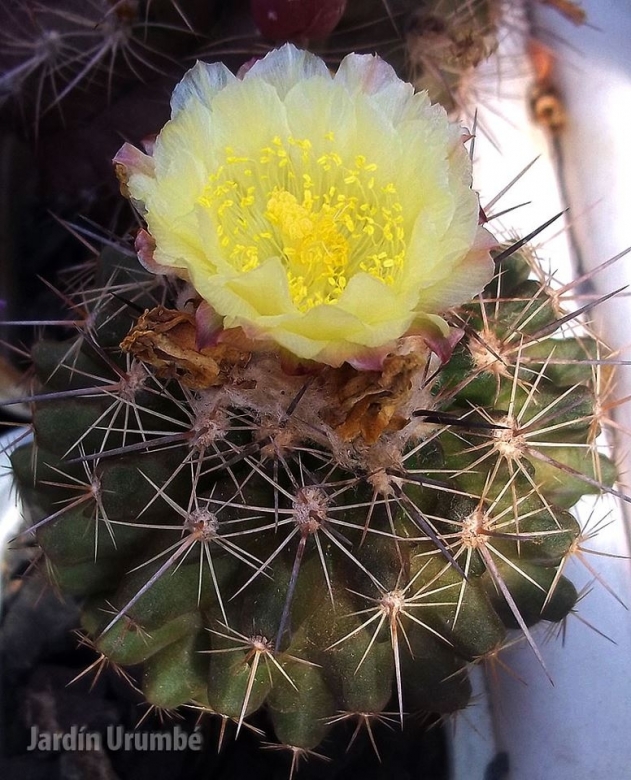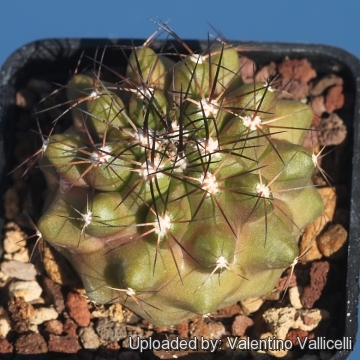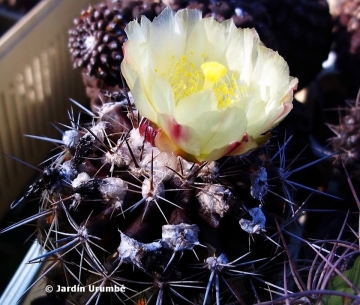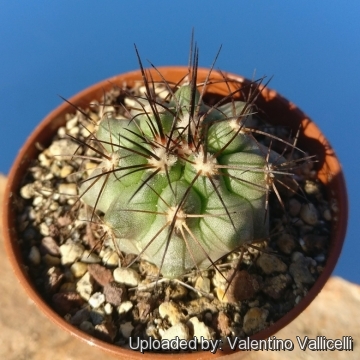
Copiapoa grandiflora Photo by: Alexander Arzberger
Origin and Habitat: Between Pan de Azucar to Cifuncho, Department of Taltal in the Atacama Desert of Chile. It is possible to find an interesting colony near Esmeralda.
Altitude: 50 to 850 metres metres above sea level.
Habitat: It grows in inland valleys and hill slopes. The climate is subtropical, but with moderate temperatures all year round: the lowest average temperature is 12,3°C - and the highest is 19,3°C. However the nights might be quite chilly in winter.
Synonyms:
Common Names include:
UKRAINIAN (Українська): Коп'япоа великоквіткова
Description: Copiapoa grandifloraSN|1424]]SN|1409]] is very like and grows sympatrically with Copiapoa cinerascensSN|1409]]SN|1420]] and presumably the two represent only the extreme of variation within the same population. Copiapoa grandifloraSN|1409]]SN|1409]] distinguishes for the smaller and greener stems and very large blooms. Ritter considers Copiapoa grandifloraSN|1420]]SN|1409]] close to Copiapoa molliculaSN|1409]]SN|1424]], which grows North of Chañaral
Habit: Body highly branched to form large, dense cushions up to 50 cm in diameter.
Roots: Thickened shortly napiform without narrow neck.
Stems: Globose to short cylindrical 13 cm tall, 6 to 10 cm in diameter, pale green to olive green often in habitat with a grey waxy coating presumably produced to prevent desiccation in it's extremely dry environment. In cultivation the waxy bloom is often not produced, revealing the epidermis colour.
Ribs: (10-)12-15(-19) rounded, tuberculate, notched, 10-12 mm high and wide.
Areoles: Big, oval about 4 mm long and 10 mm apart, covered with white wool turning grey, later glabrous.
Radial spines: 7 to 10, needle-like, rather slender, straight 1-3 cm long at first brown to black, later greyish-white.
Central spines: 1-2(-4), needle-like, more robust and slightly longer (up to 5 cm long), the same colour as the radial.
Flowers: Up to 3 cm long and 5,5 cm in diameter, pale yellow, slightly reddish outside.
Blooming season: Blossoms are born in mid spring, late spring, late summer, mid autumn.
Fruit: Round, 10-15 mm long, reddish or brownish.
Seeds: Black 1 x 0,8 mm.
Subspecies, varieties, forms and cultivars of plants belonging to the Copiapoa grandiflora group
 Copiapoa esmeraldana F.Ritter: (syn: Copiapoa grandiflora subs. ritteri) is a small growing geophytic and neotenous relative of Copiapoa grandiflora. Distribution: Guanillos valley near Esmeralda.
Copiapoa esmeraldana F.Ritter: (syn: Copiapoa grandiflora subs. ritteri) is a small growing geophytic and neotenous relative of Copiapoa grandiflora. Distribution: Guanillos valley near Esmeralda. Copiapoa grandiflora F.Ritter: has green highly branched stems that form large, dense cushions up to 50 cm in diameter, and has large blooms. Distribution: Pan de Azucar to Cifuncho, also near Esmeralda.
Copiapoa grandiflora F.Ritter: has green highly branched stems that form large, dense cushions up to 50 cm in diameter, and has large blooms. Distribution: Pan de Azucar to Cifuncho, also near Esmeralda.
Bibliography: Major references and further lectures
1) Antonio Gómez Sánchez “Enciclopedia ilustrada de los cactus y otras suculentas” Mundi-Prensa Libros, 2006
2) Stuart Max Walters “The European garden flora. 3.[Angiospermae], Dicotyledons.” [Casuarinaceae to Aristolochiaceae] Cambridge University Press, 1989
3) Friedrich Ritter "Kakteen in Südamerika" Volume 3, Friedrich Ritter Selbstverlag, Spangenberg 1979–1981, page. 1096 ff.
4) Marticorena, C. & M. Quezada. 1985. "Catálogo de la Flora Vascular de Chile" Gayana, Bot. 42: 1–157.
5) Walther Haage “Kakteen von A bis Z” Anaconda ed. 2012 ISBN: 3866472609
6) Edward Anderson “The Cactus family” Timber Press, Incorporated, 2001
7) Graham Charles “Copíapoa” Cirio Pub. Services, 1999
8) David R Hunt; Nigel P Taylor; Graham Charles; International Cactaceae Systematics Group. "The New Cactus Lexicon" dh books, 2006
 Copiapoa grandiflora Photo by: Valentino Vallicelli
Copiapoa grandiflora Photo by: Valentino Vallicelli Copiapoa grandiflora Photo by: Valentino Vallicelli
Copiapoa grandiflora Photo by: Valentino Vallicelli Copiapoa grandiflora Photo by: Alexander Arzberger
Copiapoa grandiflora Photo by: Alexander Arzberger Copiapoa grandiflora Photo by: Valentino Vallicelli
Copiapoa grandiflora Photo by: Valentino VallicelliCultivation and Propagation: This species need full sun otherwise the bodies tended to elongate in cultivation, but should be protected from excessive heat and sun in summer, Require light watering, good drainage, and deep pot to accommodate tap root. Keep warm and dry in winter to avoid rot. Frost tolerance 0°C.
Propagation: Seeds (offsets rarely), Grafting is often used to speed growth rate and to create a back-up to plants in collection.














